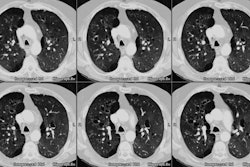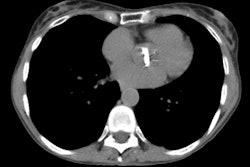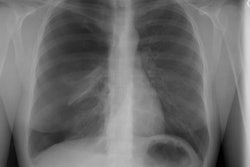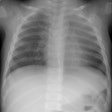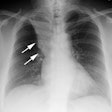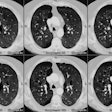Emphysema:
Clinical:
Emphysema is characterized by parenchymal destruction distal to the terminal bronchioles, without fibrosis, and irreversible airflow obstruction [13]. Pulmonary function studies are relatively insensitive to the early detection of emphysema- up to 30% of the lung units can be destroyed without producing a functional abnormality [14]. Medical treatment for emphysema involves smoking cessation, bronchodilators, steroids, supplemental oxygen, and exercise training. Lung volume reduction surgery is an option for selected patients.
X-ray:
CXR: Chest radiographs are often normal when the clinical diagnosis of obstructive lung disease is made. Radiographic findings in emphysema include hyperaeration (increased lung volume), flattening or inversion of the hemidiaphragms, bullae, an enlarge anteroposterior diameter of the chest, decreased peripheral vascular markings, narrowing of the transverse cardiac diameter, and pulmonary arterial hypertension. Narrowing of the coronal diameter of the intrathoracic tracheal air column on the PA CXR may also be seen and is refered to as a "saber sheath trachea". The coronal to sagittal tracheal ratio measured 1 cm above the level of the aortic arch will be less than 0.6 [17]. At least 95% of patients with saber sheath trachea have evidence of COPD [17].
Determination of increased lung volume is subjective, but a right lung height of 29.9 cm or more measured from the dome of the right hemidiaphragm to the tubercle of the first rib, identifies 70% of patients with abnormal pulmonary function (false positive rate 5%). Another indication of overinflation is location of the right hemidiaphragm at or below the anterior aspect of the seventh rib. Flattening or inversion of the diaphragms is also often subjective, but a height of the right hemidiaphragm on the lateral projection of less than 2.7 cm measured from anterior to posterior costophrenic angles identifies nearly 80% of patients with moderate or severe abnormal lung function. On a PA radiograph, the diaphragm is considered flattened if the highest level of the dome of the right hemidiaphragm is less than 1.5 cm above a line drawn between the costophrenic angle laterally, and the vertebrophrenic angle medially. An increased AP dimension of the chest is suggested by an enlarged retrosternal airspace greater than 4.4 cm measured 3 cm below the manubriosternal junction. Bullae are the only specific sign of emphysema, but they may not be present despite generalized disease.
Computed tomography: On computed tomography, emphysema appears as areas of low attenuation compared to the adjacent normal lung, with no definable walls. The distribution and severity of findings on CT correlate well with histopathologic specimens.
Four subtypes of emphysema have been described according to their locations in the secondary pulmonary lobule: Panlobular, centrilobular, distal lobular (paraseptal), and paracicatrical (associated with scar and fibrosis). [1,2,3]
Centrilobular emphysema:
Centrilobular emphysema is the most common form and is strongly associated with cigarette smoking. The specific pathophysiologic mechanism by which smoking causes centrilobular emphysema has not been definitively identified, but is likely related to an imbalance in protease-antiprotease activity. Cigarette smoke inactivates antiprotease protective enzymes in the lungs and causes macrophage activation within the respiratory bronchioles that release elastolytic enzymes [14]. It tends to predominate in the upper portions of the individual lobes (apices in the upper lobes, superior segments of the lower lobes). There is central destruction of the secondary lobule- alveoli around the proximal respiratory bronchioles (first and second generation respiratory bronchioles) are destroyed, while more distal alveoli are spared. The emphysematous spaces can coalesce to form bulla (sharply demarcated areas of emphysema larger than 1 cm in diameter with invisible or pencil thin walls [15]). Although there is a communication between the tracheobronchial tree and a bulla, gas exchange between them is slow [15]. Development of a fluid level within a bulla or wall thickening suggests infection [15].
Emphysema is more prevalent and more severe in HIV-positive individuals. Cigarette smoking is an important cofactor for development of emphysema in these patients, and the severity of emphysema is greater in patients with HIV infection than in HIV-negative individuals with similar smoking histories [23].
Emphysema in IV drug use: Emphysema has been reported in 2-4% of IV drug users with an upper lobe predominance and typically affecting young males [28]. The condition is strongly associated with methylphenidate injection [28]. Bullous emphysematous changes have been described in association with cocaine smoking [28]. The typical distribution is upper lobes of both lungs, especially in the periphery, with sparing of the central (medullary) portion of the lungs [28].
HRCT can demonstrate evidence of emphysema in patients with normal pulmonary function tests [15]. On HRCT, centrilobular emphysema appears as small areas (several millimeters to a centimeter in diameter) of radiolucency without visible walls surrounded by or interspersed with areas of more normal appearing lung. Very thin walls are occasionally visible and are related to areas of mild fibrosis or compressed adjacent lung [4]. With more severe emphysema, areas of destruction become confluent and the centrilobular distribution is no longer recognizable- when this occurs, the appearance is similar to panlobular emphysema [15], however, the distribution still preferentially involves the upper lung zones. Minimum intensity reconstruction images from helical CT images may make areas of emphysematous change more conspicuous [5,6].
Panlobular emphysema:
In panlobular emphysema, which predominates in the lower lungs, there is destruction of the entire secondary lobule back to the level of the terminal bronchiole (ie: There is destruction of lung distal to the terminal bronchiole. Since the acinus consists of all parenchymal tissue distal to the terminal bronchiole, panlobular emphysema affects the entire acinous). Panlobular emphysema is seen most commonly in alpha-1-antitrypsin (alpha-1-protease inhibitor) deficiency and Swyer-James syndrome. Alpha-1-antitrypsin is a protein that blocks the destructive action of neutrophil elastase on the lung elastin fibers [13]. Smoking causes an earlier onset of symptoms in patients with homozygous alpha-1-antitrypsin deficiency [13]. Heterozygous deficiency has not been associated with an increased risk for panlobular emphysema [13]. Panlobular emphysema may also be seen in smokers without alpha-1-antitrypsin deficiency ([14] although this is controversial) and the elderly. IV abuse of talc containing medications and methylphenidate (Ritalin) also have a tendency to cause predominantly lower lobe panacinar emphysematous changes [22].
On HRCT it appears as extensive areas of uniform low attenuation associated with few visible pulmonary vessels in the abnormal regions. Focal areas of lucency, bullae, and cysts are characteristically absent. Mild and even moderately severe panlobular emphysema may be subtle and difficult to detect even with HRCT- the homogeneously low attenuation provides no normal background against which the emphysematous spaces stand out. [6,15] Expiratory CT scans may help to demonstrate lack of the expected increase in lung attenuation.
Paraseptal emphysema:
Paraseptal emphysema involves the periphery of the pulmonary lobule, especially adjacent to connective tissue septa. It is most prominent in a subpleural location, typically within the apices. It is associated with spontaneous pneumothorax [27], but not with air-flow obstruction. Although paraseptal emphysema can be seen as an isolated abnormality, it is most often associated with centrilobular emphysema. Paraseptal emphysema has also been associated with idiopathic giant bullous emphysema.
On HRCT it appears as multiple lucencies at the lung periphery (immediately subpleural) delimited by normal interlobular septa. Because they are in a subpleural location and are marginated by visible walls, areas of paraseptal emphysema may resemble the appearance of honeycombing. The lack of significant fibrosis and associated centrilobular emphysematous changes often helps to distinguish the two entities. Additionally, paraseptal blebs are typically in a row one cyst in thickness, while the cysts seen in association with honeycombing are in verticle stacks of more than one cyst. The paraseptal emphsema cysts are typically larger than the 1-3 mm cysts seen in association with honeycombing. When paraseptal cysts are larger than 1 cm in size and have a wall less than 1 mm thick, they are referred to as bullae. Bullae are uncommon as an isolated finding, except in the lung apices, and although they may be seen within the lung parenchyma, a subpleural location is more common.
Treatment of Emphysema:
Single Lung Transplant:
(See "Lung Transplantation" also in this chapter) Patients with emphysema who undergo lung transplant do not have significantly greater life expectancy (1), but they can experience an improvement in their clinical performance. Approximately 5% of patients with emphysema are discovered to have an occult pulmonary malgnancy during evaluation for lung transplantation (1). Single lung transplant is the most common transplant operation for patients with emphysema, but bilateral lung transplant is preferred, especially in young patients [16]. Single lung transplant patients have less pulmonary reserve and may fare worse with problems such as obliterative bronchiolitis or penumonia [16]. Transplant for obstructive lung disease carries a longer survival than transplant for pulmonary hypertension, interstitial lung disease, or cystic fibrosis [16]. Five year survival is approximately 50% [16].
Lung Reduction Surgery:
IN patients with severe emphysema, lung reduction surgery reduces hyperinflation by the surgical removal of emphysematous lung tissue [29]. This enables healthier parenchyma to expand which improves overall lung function [29]. Lung reduction surgery improves symptoms of dyspnea and quality of life in emphysema patients while avoiding the potential complications of immunosuppression associated with lung transplantation surgery. Improved pulmonary elastic recoil and diaphragmatic and chest wall motion are felt to account for improvement in FEV1. Functional and physiologic improvements can be detected following the procedure including improvement in subjective dyspnea, exercise tolerance, and quality of life. Improvement is generally observed within the first 6 months after surgery, and can remain fairly stable for up to 3 years [11]. In general, there is a gradual decline in the initial improvement over time [26]. In one study, at 4 years post lung reduction surgery an increase above baseline FEV1 and decreased oxygen dependence was observed in 27% and 22% of patients, respectively [20]. In another study, at 6 months, 3 years, and 5 years after surgery, dyspnea scores were improved in 81%, 52%, and 40% of patients respectively [26].
Although palliation of symptoms of end-stage emphysema is an important benefit of the procedure, improvement in patient survival would be a major finding to support wider application of lung reduction surgery [21]. Recent studies have shown a 3 year mortality rate of about 30% [21] and a 4 year mortality rate due to respiratory failure of 46% [20]. Medically treated emphysema patients fare slightly worse, but long term outcome data has not yet been determined [1,20,21]. LVR also carries an immediate operative mortality rate (see below) and these patients are obviously deprived of any further survival that they might have had if they had not undergone the procedure [21]. The rate of decline in lung function after the sugery is similar to that of medically treated patients (about 100 ml decrease in FEV1 per year) [24]. This suggests that surgery produces a one-time benefit, but did not modify the subsequent natural history of the disease [24].
For the procedure, non-segmental wedge resection surgery is most
commonly performed on
both lungs during the same procedure using a median sternotomy
approach. The most
emphysematous portions of the lungs are resected to reduce total
lung volume by
20-30% [25].
Peripheral and apical bullae are preferred for the surgery to be
effective, but bullae do
not necessarily have to be present for the patient to be
considered for surgical lung
reduction. The surgical margins are usually stapled and buttressed
with bovine pericardium
(rather than laser) as there is a lower association with
persistent air leak. Good
surgical outcomes are associated with predominantly upper lung
disease and a greater
percentage of normal or compressed uninvolved lung. Poor
surgical out come is
associated with a lower lobe disease predominance, diffuse
disease, elevated PaCO2, and
advanced age. Complications include persistent pneumothorax
secondary to air leak and
death. The average mortality rate associated with the procedure is
about 4.5%
to12%, which is
much higher than that associated with elective thoracic procedures
[11,24,26]. Increased age
is associated with increased mortality. [8,9,10,12]
Endobronchial lung volume reduction:
New strategies are being developed that involve bronchoscopic
lung volume reduction (BLVR) including endobronchial valves,
bronchoscopic thermal vapor ablation (BTVA), lung volume reduction
coils, and polymeric lung volume reduction [29]. Findings that
render a patient unsuitable for intervention include giant bullae
of more than 1/3 of the lung volume, incomplete fissures at HRCT
(endobronchial valve treatment), severe homogeneous emphysema,
clinically significant bronchiectasis, and recent pneumothorax
[29]. Collateral ventilation channels such as the interalveolar
pores of Kohn and the bronchiole-alveolar canals of Lambert can
limit the therapeutic success of endobronchial valve therapy (but
are not considered to affect the other endobronchial treatment
options [29].
Endobronchial valves are unidirectional silicone valves which
prevent airflow into the target lobe during inspiration, whereas
air and mucous can exit during expiration [29]. The valves can
also be endoscopically removed if necessary [29]. The treatment
can be used for heterogeneous upper or lower lobe predominant
emphysema [29]. The two most common adverse events during the
first 12 months after placement are pneumonia distal to the valve
(4.2% of patients) and pneumothorax [29]. Development of
granulation tissue around the endobronchial valve can lead to
bleeding complications [29].
Bronchoscopic thermal vapor ablation (BTVA) is an irreversible
nonblocking technique for treatment of heterogeneous emphysema
using hot water vapor [29]. The applied thermal energy leads to
acute local trauma [29]. After the intial localized inflammatory
response, permanent fibrosis and atelectasis occur in the target
area [29]. This permits expansion of the healthier parenchyma with
improvement in overall lung function [29]. BTVA is considered
independent of interlobar collateral ventilation [29]. A
"flu-like" reaction including dyspnea, transient fever, pleuritic
chest pain, and leukocytosis is seen in most patients [29].
Adverse events seen within 6 months of treatment include COPD
exacerbation, pneumonia, hemoptysis, and inflammatory reaction
[29].
Lung volume reduction coils are placed into the subsegmental
airways of the most severely affected lobe [29]. After deployment
the coil assumes its preformed shape and compresses the
emphysematous parenchyma, resulting in volume reduction in the
target lobe [29]. The coils should be placed with a minimum
distance of 15 mm to the pleura [29]. The coils can be removed and
repositioned during the implantation procedure, but removal after
several months or years is difficult [29]. The treatment is a
nonblocking technique that is indpendent of collateral ventilation
[29]. Adverse events associated with the treatment include
dyspnea, pneumothorax, pneumonia, COPD exacerbation, and mild
hemoptysis [29].
Polymeric lung volume reduction (PLVR) is an irreversible
technique that can be used with heterogeneous and homogeneous
emphysema [29]. In PLVR a dose of 10-20mL of foam sealant is
adminsitered via a catheter into each subsegment of the target
lobe [29]. In situ polymerization occurs, resulting in local
inflammation with subsequent fibrosis and scarring [29].
Absorption atelectasis leads to lobar volume reduction [29]. The
technique is independent of collateral ventilation [29]. Adverse
events include a flu-like reaction (dyspnea, transient fever,
pleuritic chest pain, and leukocytosis), COPD exacerbation,
pneumoina, and hemoptysis [29].
Unsuspected bronchogenic carinoma can be found at CT in 2 to 5% of patients being considered for lung volume reduction surgery and nearly 90% of these will prove to be stage I lesions [18]. Combined lung reduction surgery and wedge resection of pulmonary nodules known or suspected to be bronchogenic carcinoma can be performed, but the outcome is usually less satisfactory when compared to reduction surgery alone [1].
Criteria for lung reduction surgery candidates:
Inclusion criteria: Severe emphysema with hyperinflation, forced expiratory volume in 1 second 10-40% of predictaed, residual volume greater than 180% of predicted, and total lung capacity over 110% of predicted.
Relative contraindications/Exclusion criteria to the procedure are numerous and include:
General: Age over 75 (80) years, obesity, current smoking, bronchiectasis, malignancy, active ischemia or severe heart disease, prior median sternotomy or lung resection, significant pleural abnormalities, six-minute walk less than 250 feet (after rehab), disease likely to limit survival to less than 5 years, mental incompetatncy or active psychiatric illness, and associated interstitial lung disease (these patients are directed to transplant).
Pulmonary: A pCO2 greater than 50 mm Hg, DLCO less than 25% of predicted, dependence on a ventilator, supplemental O2 requirement over 6 L/min (for SaO2>87%), over 1 cup of suptum production per day, or pulmonary arterial hypertension.
REFERENCES:
(1) Radiographics 1997; Imaging of emphysema and lung volume reduction surgery. 17 (4): 1023-1036 (No abstract available)
(2) AJR 1994; Apr 162 (4): 791-798
(3) ACR Syllabi #40: p.37
(4) HRCT of the Lungs, 2 nd ed. p.87
(5) Radiology 1996; 200: 665-671
(6) Radiographics 1997; 17: 377-390
(7) AJR 1997; Lung volume reduction surgery: radiographic findings in the early postoperative period.168: 755-761 (No abstract available)
(8) Radiology 1997; 203: 705-714
(9) Am Roent Ray Society Meeting 1996, Abstracts #137-141
(10) Radiology 1997; Lung volume reduction surgery: let the trials begin. 204: 613-615 (No abstract available)
(11) Radiology 1997; 204: 685-693
(13) Radiol Clin North Am 1998; Stulbarg MS, et al. Obstructive pulmonary disease: The clinician's perspective. 36 (1): 1-13
(14) Radiol Clin North Am 1998; Gurney JW. Pathophysiology of obstructive airways disease. 36 (1): 15-27
(15) Radiol Clin North Am 1998; Takasugi JE, et al. Radiology of chronic obstructive pulmonary disease. 36 (1): 29-55
(16) Radiol Clin North Am 1998; Slone RM, et al. Preoperative and postoperative imaging in the surgical management of pulmonary emphysema. 36 (1): 57-89
(17) Radiol Clin North Am 1998; Stark P, et al. Imaging of the trachea and upper airways in patients with chronic obstructive airway disease. 36 (1): 91-105
(18) Radiology 1998; Rozenshtein A, et al. Incidental lung carcinoma detected at CT in patients selected for lung volume reduction surgery to treat severe pulmonary emphysema. 207: 487-490
(19) Radiology 1999; Maki DD, et al. Advanced emphysema: Preoperative chest radiographic findings as predictors of outcome following lung volume reduction surgery. 212: 49-55
(20) Chest 1999; Gelb AF, et al. Lung function 4 years after lung volume reduction surgery for emphysema. 116: 1608-1615
(21) Ann Thorac Surg 1999; Naunheim KS, et al. Long-term survival after thoracoscopic lung volume reduction: A multiinstitutional review. 68: 2026-2032
(22) AJR 2000; Ward S, et al. Talcosis associated with IV abuse of oral medications: CT findings. 174: 789-793
(23) Society of Thoracic Radiology Annual Meeting 2000 Course Syllabus; King MA. Lung disease in HIV-positive individuals without AIDS. 105-107
(24) N Engl J Med 2000; Geddes D, et al. Effect of lung volume reduction surgery in patients with severe emphysema. 343: 239-245
(25) Radiology 2002; Hunsaker AR, et al. Lung volume reduction surgery for emphysema: correlation of CT and V/Q imaging with physiologic mechanisms of improvement in lung function. 222: 491-498
(26) Chest 2003; Yusen RD, et al. A prospective evaluation of lung volume reduction surgery in 200 consecutive patients. 123: 1026-1037
(27) Radiol Clin N Am 2005; Gotway MB, et al. High-resolution CT of the lung: patterns of disease and differential diagnoses. 43: 513-542
(28) Radiographics 2007; Restrepo CS, et al. Pulmonary
complications from cocaine and cocaine-based substances: imaging
manifestations. 27: 941-956
(29) AJR 2015; Grabenhorst M, et al. Radiologic manifeststions of
bronchoscopic lung volume reduction in severe chronic obstructive
pulmonary disease. 204: 475-486

